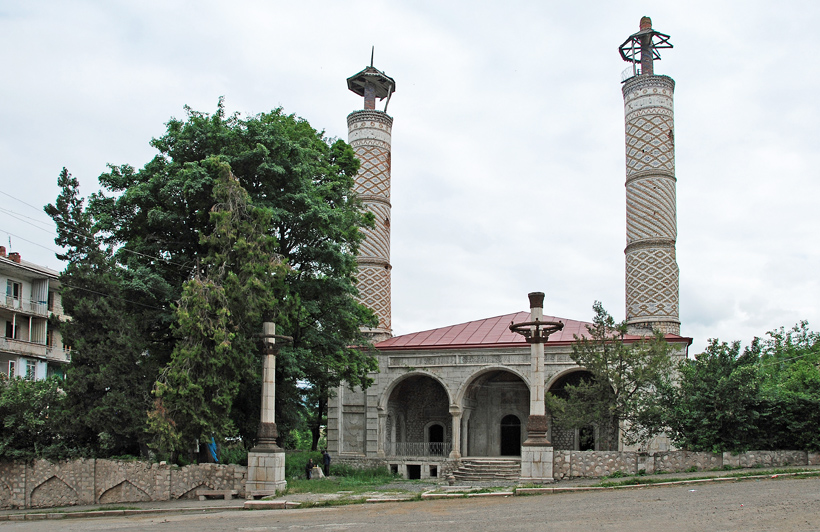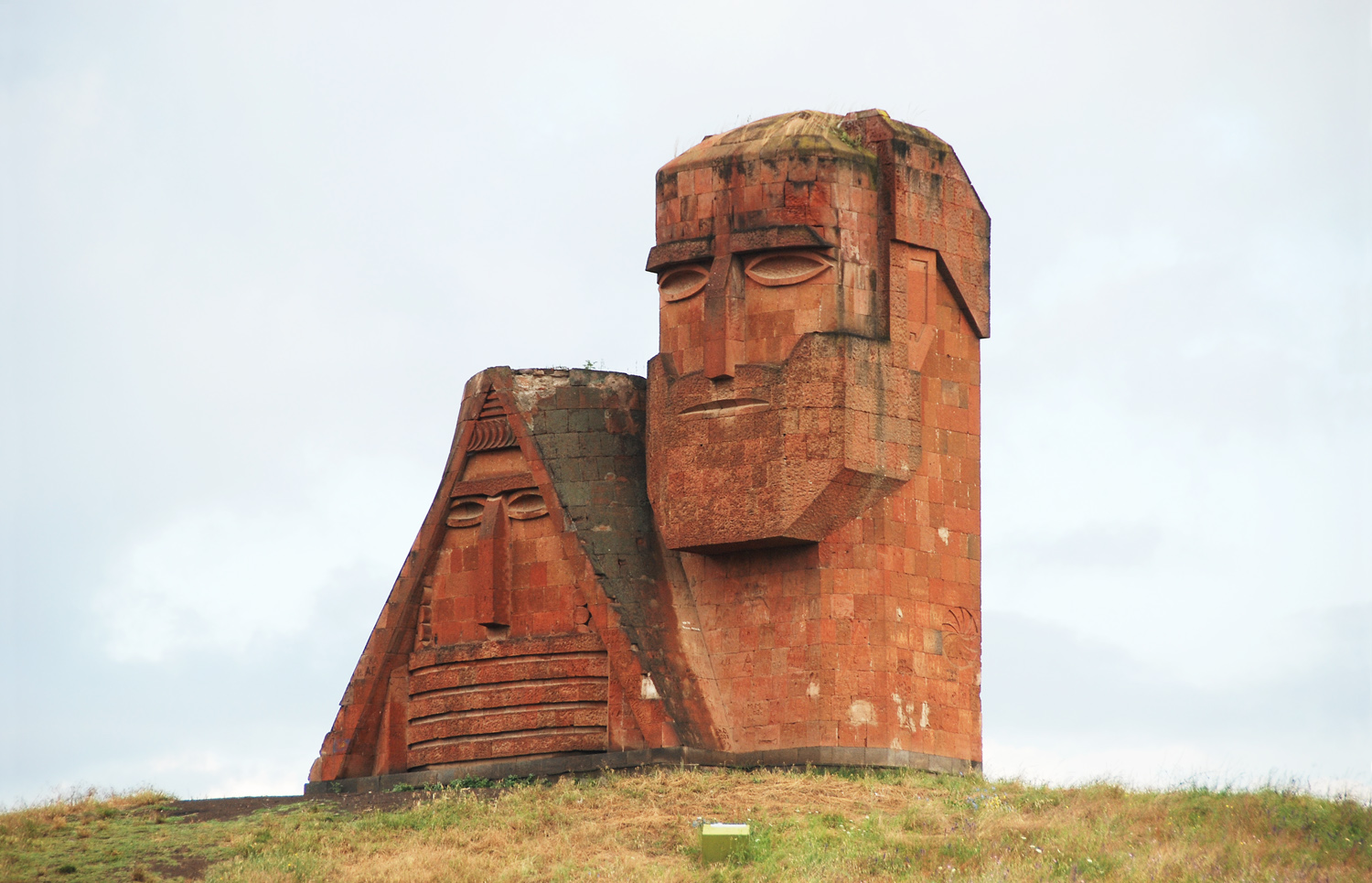The last part of our Armenian Adventures takes us to Nagorno-Karabakh, a de facto independent but unrecognized state within Azerbaijan (I’m sticking to the Wikipedia entry to avoid debates).
Before heading to Karabakh, we made one last stop at the Goris market and nearby stores, where the usual Armenian produce (peppers, eggplant, zucchini, beans, radishes, tomatoes, watermelon and apricots) share room with some meat and freshwater fish — not refrigerated, of course!
So let me now start with some practical information for the prospective tourists. All foreign visitors (except the ones from some of the former Soviet Republics) need to obtain a visa just for Nagorno-Karabakh. You can find detailed information here, although unlike what is said on this site and in travel guides, I was able to get my visa by mail from the Nagorno-Karabakh permanent representation in Washington, DC. Things may have changed, but it’s definitely worth giving these guys a call. Here’s what my visa looked like, back in summer 2009:

The only way into Karabakh is from Armenia. Coming from Azerbaijan is completely out of question. I do see a bridge on the map at the Iranian border, near the Khoda Afarin reservoir, but this is not an official crossing point and I couldn’t find any information about it. This bridge is so remote, sandwiched between destroyed Azerbaijani villages and the Alborz moutain range, that I’d be very curious to hear from someone who’s been there!
The most usual road (but not the only one, as we’ll see later) goes from Goris through the infamous Lachin corridor. At the border, you will have to stop briefly at a police check, where they will write down your information into a book that I bet nobody will ever read. As you will find out pretty soon, Karabakh feels like a part of Armenia more than an independent country. There may be a puppet president, but the people, language, currency, police and army are all Armenian. The picturesque road to the capital Stepanakert was rebuilt thanks to donations from the Armenian diaspora and is in excellent condition (like most roads in Armenia, really):
Upon your arrival in Stepanakert, you will have to register at the NKR Foreign Ministry. This can be slightly more complicated than it seems. When we got there, the whole town center was experiencing a blackout, and we only miraculously managed to get the paperwork done much later in the evening.
If Stepanakert is trying hard to rebuild, to turn the page of the conflict with Azerbaijan, there is still a lot to do in the rest of the region. Here’s an appartment building in the center of Shushi, a town that used to have a predominantly Azerbaijani population and changed hands several times during the war:

All the mosques in Shushi have been destroyed or heavily damaged, like the Upper Govhar Agha Mosque:

But the systematic destruction of former Azerbaijani communities is nowhere as obvious as in Agdam, a city that once had a population of 40,000 people and has become a ghost town. All of the buildings have been gutted, and sometimes completely razed, to prevent the Azerbaijani population from coming back — something you see on a smaller scale throughout Karabakh and even Armenia.
The ruins remain a buffer zone for the Armenian army and are technically banned for sightseeing. Getting there isn’t too hard though: the access road is simply blocked by a small chain and everybody drives around it. This is the paradox about Agdam — the whole town is supposed to be off limits, but you certainly see a lot of cars crossing it, and there’s even a gas station!
I would have liked to push to the town center to see what’s left of the mosque, one of the last buildings still standing, which offers a nice panorama of the area. Unfortunately, as I was discretely taking pictures with my telephoto on the side of the road, we were reprimanded by a man in camo pants who threatened to call the KGB if we didn’t turn around immediately. We didn’t have the presence of mind to tell him that the KGB stopped existing 20 years ago. We simply drove back — something that I slightly regret to this day.
You can see more of Agdam in this video or on this blog.

Luckily, there are enough sights that are well worth a visit in the rest of Karabakh, such as monasteries and fortresses. I won’t cover these attractions in this post, as they’re off-topic and your favorite travel sites and books will certainly do a much better job than me, anyway. I’ll just say Karabakh is no Abkhazia, where there’s little to see except for Soviet relics and equally Soviet beaches, and where your life might me threatened more than once (see my Georgian Adventures, parts 7 and 8).
The best way to leave the region without spending several hours driving back the way you came is to take the road from Dadivank over the Zod Pass, at 2,400 meters. You may read in travel guides that the road is impassable, but in summer it never gets worse than what you see on the pictures below. Compared to Georgia, this is a top-notch road that hardly justifies driving a four-wheel drive! The abandoned tanks on the side of the road add some cachet to the journey.
The very scenic road follows the valleys of the Tartar and Lev rivers, sometimes between impressive cliffs, before reaching the Zod gold mines in Armenia. As you can see, besides the cultural visits, the geographical configuration of the region as a montainous plateau makes for spendid landscapes.
Expect a recipe for zhingalov khats, a specialty from Karabakh, in the near future. Then I’ll cross the enemy lines (figuratively!) and start a new series on my adventures in Azerbaijan.














3 comments
“Nagorno-Karabakh, a de facto independent but unrecognized state within Azerbaijan”
You are probably working for Azeri interests. The NKR government should do a better job at keeping out you parasites next time. It’s also interesting that with all the places you avoided, you managed to show a “damaged mosque” – as if that was so important. And you say Shshi had “majority Azeris” before the NKR war – yeah sure they did, right after driving out the Armenians 100 years ago with acts of Genocide, that is to be expected. You are a fool if you are acting independently and believe all the drivel you wrote.
Hello, just an update. I was in Armenia this summer and we drove to Karabakh and didn’t need Visas. We were not stopped at the border at all. Also, the first time I was in Stepanakert was in 1997 and going back 18 years later I was in awe when I saw how much it has changed. I had to explain to my husband how war torn it had been because there was no evidence or signs of anything. Oh, my mouth is watering just thinking about the zhingalov hatz we had from their open market! YUMMY!
Thanks for the update, lorithenaz!